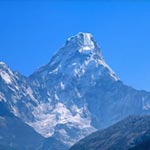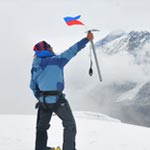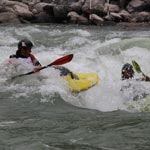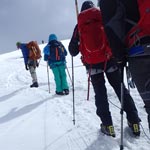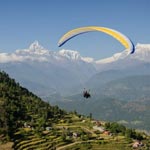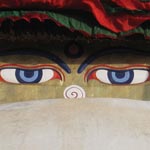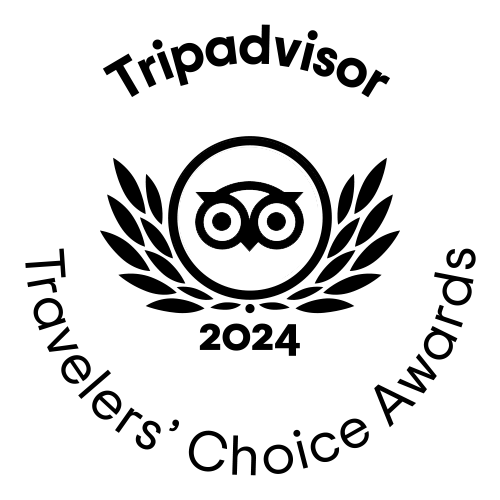Nepal lies between two powerful countries of Asia between India and China as a landlocked country. One of the richest country Nepal in the world in terms of bio-diversity due to its unique geographical position and altitude variation. The elevation of the country ranges from 60 meters above sea level to the highest point of the world, Mt. Everest at 8,848 meters above sea level. We have a beautiful Himalayan range in the north and have many rivers that begin from the Glacier of the Himalaya. Nepal has three major geographical ranges; the Himalayan region, the Hill region, and Terai's low land. Unity in diversity and vice versa is the main feature of Nepal. Approximately 30 million people live here, with 125 ethnic groups and 134 dialects that practice their own culture and traditions. From 200 meters of subtropical width to the Arctic climatic conditions, the terrain changes from a minimum of 70 meters to 8848 meters, the highest peak in the world. Nepal has many different cultural heritages, including Lumbini, the birthplace of Buddha.
Being based on this fact, many international tourists are indeed incorporating Nepal in their preferred travel itinerary. Nepal is known for its beautiful and dramatic scenery. Passionate walkers and non-walkers alike are attracted to its mountains and foothills to view the Himalaya and the world's highest peak. Many also discover the beauty of the forests and the enjoyment of time spent as a self-contained expedition, far from the rush of the modern world and in the delightful company of the trek crew as they tend to our needs and ensure that we are comfortable and able to enjoy the trek to the fullest. They are physically strong, sharp-witted and have an incredibly positive attitude towards a life that we would consider extremely tough. There is something trek in the Himalaya that draws you back time and time and again. More than five million people live in Kathmandu Valley, but at least ninety percent of the population lives in the rural areas of the lower and middle hills of the Himalayan Range. Nepal is predominantly a simple rural society. Nepal has been declared Federal Republic State on May 28th, 2008. This historic development followed the first elections held since 1999 after a ceasefire agreement between the government and the Maoists was signed in November 2006, putting an end to 10 years of instability in the Kingdom. The announcement of the abolishment of the Monarchy also brought an end to 240 years of Royal rule in the country. Today the general feeling amongst Nepalese is a positive one, and many believe that Nepal is now finally moving forward with a new identity as a democratic nation and a fresh outlook. All we people hope a lot for further progress.
The Nepal Integrated Travel Guide contains basic and quick information about travel in Nepal and provides tips, topics and other information related to travel.
General Facts
Name: Federal Democratic Republic of Nepal
Area: 147,181 sq. kilometers
Geography: Situated between China in the north and India in the south
Capital City: Kathmandu
Population: 2,642,799
Language: Nepali is the native language. However, travel-trade people understand and speak English as well.
Currency: Nepali Rupee
Political System: Multi-party democracy
Religion: The major number is Hindu. However, there is a harmonious blending of Hinduism, Buddhism and other religious people.
People: Nepal has more than 101 ethnic groups and 92 different spoken dialogues.
Primary Airport: Tribhuvan International Airport (TIA)
What Is Namaste/ Namaskar?
Namaste is the most popular form of greeting, especially the elders, and when, we see new clients or new people is to say Namaste with the hands joined at the chest level. It is also used at the time of farewell. It is very common in Nepal.
Climate: Nepal has four major seasons:
- Winter: December-February
- Spring: March-May
- Summer: June-August
- Autumn: September-November
Best Time to Travel Nepal
- Autumn (September, October, and November)
- Spring (March, April, and May) are the best seasons for high altitudes and climbing activities.
- Winter (December, January, and February) are good months for low altitude treks and tours.
- Monsoon (June, July, and August) is also okay to visit Nepal but visibility could be of matter due to rain.
Visa Information
Nepal issues visas on arrival for citizens of most countries. The tourist visa for 15, 30, & 90 days cost USD 30, 50 & 50 respectively.. Check your visa requirements here. You must bring a passport-sized photo, or stand in line and pay for one when you arrive. Volunteers technically require a visa arranged by the place they are working with as volunteering on a tourist visa is expressly forbidden, though harder for them to enforce.
Passport and Visa Requirements
All foreigners require a visa for entry into Nepal (except Indian nationals). It is your responsibility to obtain an entry visa. You can get from a Nepalese embassy overseas or on arrival in Nepal. Most people will obtain their visas on arrival at Kathmandu airport. You will need one passport photo and the following fees dependent upon the duration of the multiple entry visas:
In Nepal, you will require a visa which can be obtained in advance from the Nepalese Embassy from your country or you can get on arrival at the airport in Kathmandu.
- Multiple entry 15 days US$ 30 or equivalent convertible currency
- Multiple entry 30 days US$ 50 or equivalent convertible currency
- Multiple entry 90 days US$ 125 or equivalent convertible currency
You will require visa fee in cash (this is payable in any major currency but NOT travelers' cheques) and 2 passport photos to purchase a Nepal visa on arrival at Kathmandu airport or at the Nepal entry point.
Please note regulations and costs do change frequently so it is advisable to check the current rules with your nearest Nepalese embassy or consulate.
(for more details please contact, Department of Immigration Maitighar Impact Building Kathmandu, Contact: 00977-1-4221996/ 4223590/ 4222453)
Health
Owing to a sudden change in climate, altitude and other factors, it is obvious that there could arise some alterations in your health. It would be hard to know all aspects of Nepal's health problems. However, it would be useful to gather information on altitude sickness (AMS), diarrhea, dysentery, cholera, hepatitis rabies, typhoid, tetanus, meningitis diphtheria, malaria, and HIV/AIDS. Common sense can often save lives. You will be eating and drinking in various outlets. Diarrhea is a common illness that a tourist would be facing. So, it is recommended to drink purified water and eat in clean outlets. Drinking and eating precautions will surely help to take care of many health problems that could arise during the trip. Staying hydrated during the travel, trekking, tours are highly recommended too. Being in good health before leaving for a trip would help you to enjoy your trip to the fullest.
Physical Checkup:
We always recommend undergoing a thorough check-up before commencing travel to Asian countries so that if you are considering demanding tours such as trekking or mountaineering you do not have doubt about your health or fitness.
Vaccinations:
There is no need to present inoculation/immunization certificates to enter Nepal for any legal purpose. However, vaccination for diseases such as Malaria (widely found in lower lands of Nepal – Terrain), Small Pox, Typhoid, Tetanus, Meningitis, Hepatitis, and Polio are recommended before you commence your travel to Nepal to be on the safe side. We advise you to consult your doctor before beginning your travel and also to carry necessary health certificates (immunization certificates), should they be required in any case. Given notice, your doctor will be able to administer all the above vaccinations.
Altitude Information:
AMS (acute mountain sickness) is a serious issue. It is the result of the failure of the body to adapt to high altitudes and can affect anyone, regardless of age or fitness. It usually occurs above 2,500m and the likelihood of being affected increases as you ascend. The way to reduce the effects of altitude is to ascend slowly, 300 meters per day above 3,000 meters until you have acclimatized. Poor acclimatization results in a headache, nausea, sleeplessness, difficulty breathing and swelling of fingers and glands. The only cure for AMS is to descend to the lower altitude and your guide’s decision on this matter is final.
Although our routes are carefully planned to allow for proper acclimatization you may feel some effects of altitude for the first few days or at higher altitudes. Breathlessness, lethargy and mild headaches are not uncommon and generally decrease as your body adjusts. Maintaining adequate fluid intake is essential. Please advise your guide if you feel more severe symptoms and do not medicate yourself without discussing it with them first.
Postal Services:
Central Post Office located near Sundhara or Bhimsen Tower is open from 9 a.m. to 5 p.m., Sunday through Friday. The counters are open from 10 a.m. to 4 p.m. and provide stamps, postcards, and aerograms. Post Restante is available Sunday through Friday from 10 a.m. to 5 p.m. Express Mail Service (EMS) is available at GPO and at Thamel, Basantapur, and airport postal counters.
Telephone Services:
Telephone, fax, telex and telegraph services are available at the Nepal Telecommunications Corporation at Tripureshwar. Hotels and private communications centers provide a long-distance telephone. For calling from outside, the country code for Nepal is 977 and the area code for Kathmandu is 01.
Internet Services:
There are several internet cafes and communication centers in the Kathmandu Valley and around the country. Tourists only need to find a place they are most comfortable with to use the facilities to keep in touch with home. E-mail and Internet services are also offered by hotels.
Media:
Nepali media has developed rapidly within just a few years of time. Besides the government media, Radio Nepal and Nepal Television, there are numerous FM and television networks, numerous FM radio stations, and upcoming regional television stations are dominating the market. Major Nepali daily newspapers are Gorkhapatra and Kantipur, Nagarik, while the English dailies are Rising Nepal, The Kathmandu Post, Republica, The Himalaya Times, etc.
Forex and Banking
Foreign currencies must be exchanged only through banks or authorized foreign exchange dealers. The receipts from such transactions are to be obtained and retained. Visitors can exchange money at the foreign exchange counter at the airport upon arrival.
Payment and Card System
Credit cards like the American Express, Visa, and Master Card will accept by Aiming Adventure and most of the store, restaurant and tourist hub. Convertible currencies are as follows: Dollar (U.S., Australian, Hong Kong, Canadian, and Singapore); Euro (Swiss, French, Belgium, Netherlands, Germany, Italy); Pound (U.K.); Yen (Japan). Please keep hold of your encashment for changing back local currency into foreign currency on departure at exit points or at Tribhuvan International Airport departure lounge.
ATM Systems in Nepal
The mainstream banks in Kathmandu and Pokhara all have a cash machine where you fill your wallet 24 hours a day using your normal bank card or Master Card / Visa. Banks have cash machines, though we would recommend only using these machines during bank opening hours so as not to run the risk of losing your card if the system crashes.
Banks in Kathmandu Valley are open between 9:30 a.m. to 2:30 p.m. from Sunday through Friday. They are closed on Saturdays and other public holidays. In other places, banks are open from 10 a.m. to 2:30 p.m. from Sunday to Friday and are closed on Saturdays and government holidays. ATM machines are located in many banks in the capital. Money can be transferred from other parts of the world from the numerous transfer agencies in the capital.
Accommodation facilities
Nepal has a huge range of options regarding the hotel. According to your desire, you can book the hotel from cheap, basic rooms for backpackers to five-star hotels, and some of the tea houses, etc. A general outline of facilities available in five, four and three-star hotels are given below:
Five Star Hotels:
A five-star hotel has all its rooms air-conditioned, well-furnished and with attached bath. More than two restaurants and bars serving a variety of cuisine and drinks, swimming pool, tennis court, beauty parlor, sauna, health club. Banquet and conference facilities and a variety of other modern luxurious facilities are also available.
Four Star Hotels:
The four-star hotels in Kathmandu constitute of the air-conditioned, well-furnished room with an attached bath, more than one restaurant, garden, banquet, and conference facilities – though on a slightly smaller scale.
Three Star Hotels:
The three-star hotels have air-conditioned rooms with attached bath and standard furnishings. A minimum of one restaurant and bar are available with standard luxury.
Climate in Nepal
The seasons in Nepal are pretty much the same as in Europe, opposite of the Australian seasons. In January it's cold, while in July you could make do with shorts and a t-shirt. The climate of Nepal is moderate which means the winters are dry and the summers are hot. But because of the huge range in altitude and landscape, the climate of Nepal differs significantly throughout the country. Usually, the monsoon is approximately from the end of June to end of August. About 80 percent of the rain falls during that period throughout the country but the remainder of the year is dry. Spring (March to May) and autumn (September to November) are the most pleasant seasons. Winter (December, January, and February) temperatures drop to freezing with a high level of snowfall in the high mountains.
Summer, monsoon and late spring temperatures range from 28ºC (83ºF) in the hill regions to more than 40ºC (104ºF) in the Terai (southern plains). In winter, the average maximum and minimum temperatures in the Terai range from a brisk 7ºC (45ºF) to a mild 23ºC (74ºF). The central valley experience a minimum temperature but not often falling below freezing point and a chilly 12ºC (54ºF) maximum.
The Kathmandu Valley has a mild climate most of the year, situated at an altitude of 4,297ft (1,310m). Summer temperatures range from 67-81°F (19-27°C), and in winter temperatures are between 36 and 68°F (2-20°C). During the rainy monsoon season between June and August, there is an average rainfall of between 7.8-14.7 inches (200-375mm) in Kathmandu. May and June can be very hot and humid until the monsoon rains bring relief. In spring (March to April) and autumn (October to November) the temperatures are pleasant with occasional short bursts of rain, while November to February is dry, but can be very cold, especially at night.
Transportation
Vehicles in the cities are easy to organize, taking the form of a bus. If you are frustrated, do not look at the curve on the bus. Buses are the main form of transport, but Nepal has serious infrastructure problems, so be careful. However, buses are effective and are actually the only budgetary options. Bicycles and taxis are perfect for navigating through Kathmandu.
Best time to visit Nepal
Most recommended seasons for trekking are autumn (Sept, Oct, Nov) and spring (March, April, May). In these seasons you will be rewarded with good weather, sunny and warm with the clear sky and outstanding views. During the monsoon (June, July, Aug) although there will be no problem for trekking, the issue could be of less visibility and rain. But, for a keen botanist, the monsoon is a blessing as the higher valleys, mountains, and meadows blossom with flowers and abundant vegetation. You can trek in winter (Dec, Jan, Feb) also, only the issue is cold weather with snowfall at higher elevations.
The trekking routes are crowded during spring and autumn but during monsoon and winter the routes are not packed and you could enjoy rather the best of nature. However, because of the effects of global warming, the climate is changing worldwide and there could always be the possibility of exception in these weather patterns. In the best seasons also there could be the hoax of bad weather and sometimes even in adverse months; weather tends to be excellent for trekkers.
How to get into Nepal?
By Air:
When you plan to fly directly to Nepal from your hometown or country, Tribhuvan International Airport in Kathmandu is only International Airport in Nepal. There are regular flights from Osaka, Shanghai, London, Frankfurt, Hongkong, Singapore, Bangkok, Dubai, Delhi, and Calcutta, to Tribhuwan International Airport, Kathmandu. The available Airlines that get you to Nepal are Indian Airlines, Thai International, Bangladesh Biman, China Southwest Airlines, Druk Air, Qatar Airways, PIA- Pakistan Airlines, Gulf Air, Sahara Airlines, Jet Air, Silk Air and Etihad Airways, and Himalayan Airlines.
By Overland:
- Kakarvitta, Jhapa (Eastern Nepal)
- Birganj, Parsa (Central Nepal)
- Kodari, Sindhupalchowk (Northern Border)
- Belhiya, Bhairahawa (Rupandehi, Western Nepal)
- Jamuna, Nepalgunj (Banke, Mid-Western Nepal)
- Mohana, Dhangadhi (Kailali, Far Western Nepal)
- Gaddachauki, Mahendranagar (Kanchanpur, Far Western Nepal)
What to wear in Nepal:
light woolens and cotton are sufficient for daywear and some warmer attire necessary in the evenings. During the winter, we need Heavy woolen. We would like to suggest to respect all Nepali culture and dress up. Please wear what Nepali people were.
Things to do in Nepal
Nepal offers various activities to do who want to visit here. You just have to make a plan. Nepal changes into reality. Here are the major activates:
- Trekking
- Peak Climbing
- Expedition (in any mountains)
- Tour (day or longer)
- Jungle safari
- Adventure Sports
Crime in Nepal:
Nepal has a very low crime rate. Lower still within the tourism sector. Petty crime is virtually nonexistent. Most "crime" occurs via the service industries. e.g., volunteers losing money through corrupt organizations or donating money to corrupt orphanages.
Tourist Police in Nepal:
In most major locations, you will find the tourist police - dedicated to helping tourists with any crime issues that might occur.
There are tourist police offices located in Bhrikutimandap (Central Office), Thamel, Basantapur, Pasupatinath, Soyambhu, Airport, Mangal Bazar, Patan, Bhaktapur, and Nagarkot. Kakkarvitta Jhapa, Lukla, and Solukhumbu. Mid Region: Janaki Mandir Dhanusha, Birgunj Parsa, Sauraha, Chitwan and Syaprubesi Rasuwa. Western Region: Pokhara Baidam Kaski Dhampus Kaski Ghandruk Kaski Birethanti Kaski Chame Manang Jomsom Mustang Gorepani Myagdi Belhiya Rupendehi and Lumbini Rupendehi
Earthquake Information 2015
On April 25th a 7.3m earthquake hit Nepal followed on aftershock. Over 8.1 million people were affected. 8,700 died with the final number expected to reach 10,000. Several of Nepal's historical temples were destroyed. Many more earthquakes. Nepal was quickly helped by a vast international aid effort, which directly rescued over 1,200 people from the rubble and delivered aid to thousands more. Nepal’s tourism infrastructure was not directly affected. The vast majority of the Kathmandu Valley temples survived. Only 2 out of 30+ trekking routes were closed. Nepal is currently in the process of rebuilding. Almost one-third of its economy relies on tourism and tourists support an unofficial number of 25% of the population. Nepal is officially open to tourists with both the government and the people of Nepal asking more tourists to come.
Should I leave Tips in Nepal?
In 2008 Nepal introduced a 10% service and 13% VAT charge. If this is included in restaurants then I would not leave a tip. But when you are in the mountain or any trekking region 10% service charge is not included but still you do not have to tip. Nepal is not North America. The native culture here is not to tip. For guides and porters if you feel their service has been beyond, then adding 10% - 15% is about right. Again, it's not compulsory and although everyone likes to receive, it’s not in the culture. Doing so changes this for the worse as I've seen in many countries
Travel Insurance
A travel insurance policy that covers theft, loss and medical problems is best for traveling in Nepal. There are a wide variety of policies available, so check the small print carefully. Make sure you are covered for adventure activities and high altitude. Since you reach above 4000 meters on quite a few treks in Nepal, it is best to choose a policy that covers medical and emergency repatriation, including helicopter evacuation for trekkers and general medical evacuation. Also, understand that most medical treatment and facilities/hospitals must be paid for at the point of delivery of the patient. So it’s wise to choose a policy that pays doctors or hospitals directly rather than you having to pay on the spot and claim later.
Good to know before/ while traveling in Nepal
|
English |
Nepali |
|
Hello! |
Namaste |
|
How are you? |
Tapailai Kasto cha? |
|
I am fine. |
Malai thik cha |
|
Have you eaten? |
Tapaile khanu vayo? |
|
What is your Name? |
Tapaiko name k ho? |
|
My name is Ramesh. |
Mero name Ramesh ho. |
|
Excuse me/ Pardon me/sorry |
Maph garnus |
|
I don’t understand. |
Maile bujina |
|
I understand |
Maile buji |
|
How much? |
Kati Paisa vayo? |
|
We will meet again. |
Hami feri vetni chau. |
|
See you. |
Feri Vetaula |
|
Thank you. |
Dhanyebad |

